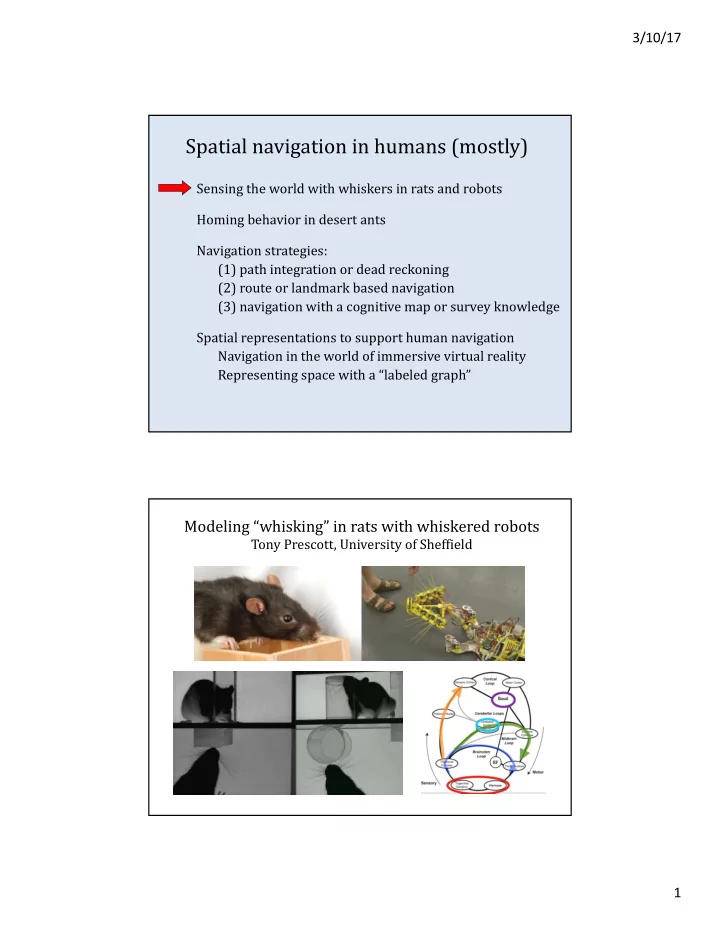

3/10/17 Spatial navigation in humans (mostly) Sensing the world with whiskers in rats and robots Homing behavior in desert ants Navigation strategies: (1) path integration or dead reckoning (2) route or landmark based navigation (3) navigation with a cognitive map or survey knowledge Spatial representations to support human navigation Navigation in the world of immersive virtual reality Representing space with a “labeled graph” Modeling “whisking” in rats with whiskered robots Tony Prescott, University of Sheffield 1
3/10/17 Homing behavior in desert ants food search path homeward Desert ants compute path straight path home after Location represented circuitous outward path nest in 2D or 3D space? Do ants count steps? “… desert ants must have developed some other cognitive mechanism to find their way back home” Scientific American, The Thoughtful Animal Spatial navigation in humans (mostly) Sensing the world with whiskers in rats and robots Homing behavior in desert ants Navigation strategies: (1) path integration or dead reckoning (2) route or landmark based navigation (3) navigation with a cognitive map or survey knowledge Spatial representations to support human navigation Navigation in the world of immersive virtual reality Representing space with a “labeled graph” 2
3/10/17 Navigation strategies Path integration (aka dead reckoning ) • update distance and direction traveled from a starting point • standard test for path integration ability: triangle completion task Route or landmark based navigation • remember specific sequences of positions, turns, landmarks, junctions • series of place-action associations • detours can be challenging if only use remembered routes Navigation guided by a cognitive map or survey knowledge • map may encode metric distances and angles between objects • enables novel shortcuts , general route planning • but routes still helpful to avoid constant planning from map • path integration and routes can be used to build cognitive map Spatial navigation with immersive virtual reality • immersive virtual reality gives subjects a realistic interactive environment • subject moves freely in a 12m x 12m room • 3D location and orientation is tracked continuously, visual input updated • cues: stereo/motion vision, proprioception, vestibular 3
3/10/17 From route knowledge to survey knowledge? It has often been suggested that... When learning the layout of a new environment, humans first learn particular routes to important locations, then gradually build up survey knowledge of the environment Many researchers have assumed that... We ultimately build a cognitive map that captures metric information about distances and angles Questions: Foo, Warren, Duchon & Tarr (2005, 2007) Do humans integrate route-based knowledge into survey knowledge of environmental layout? If so, what is the geometric structure of this spatial knowledge? • do we represent metric properties e.g. distances, angles between known locations? • or “weaker” geometric knowledge of layout? Do humans combine traveled routes into a survey representation that permits metric navigation in the environment? • two virtual worlds: desert or forest (8 subjects each) • subjects learn two paths (home-blue, home-red) to remembered target locations , with fixed angle between the paths, until consistent, high accuracy • after training, walk novel shortcut between endpoints • if subjects represent metric information about distances and angles, should accurately walk novel shortcut • if subjects rely on landmarks, expect more accurate performance for forest scene 4
3/10/17 Do humans build survey knowledge from learned routes? Does such survey knowledge preserve metric distances, angles? Desert: initial bearing and distance to target was good for practiced legs, but large accumulated errors over path, not accurate shortcuts, undershoot turning angle and distance, no corrections Forest: greater accuracy in reaching targets for both practiced paths and shortcuts, midcourse corrections Without landmarks, humans cannot accurately perform simple shortcuts, spatial knowledge does not support navigation based on survey knowledge of metric distances, angles Further exploring the role of landmarks to guide navigation • same task as before • virtual world: desert with 7 posts • after training, translate or rotate posts near red target, on some trials (different subject groups) • landmarks near start of shortcut helped initial bearing, but then large errors accumulated • landmarks at end of shortcut: rely on as “beacons” for navigation Also suggests that our “survey no change translated rotated knowledge” is not accurate 5
3/10/17 Exploring sources of spatial knowledge Virtual world: hedge maze Subjects explored maze for 10 minutes to learn locations of 8 objects active vs. passive exploration (free vs. guided) Different cue combinations during exploration: visual + vestibular + podokinetic (walking) visual + vestibular (wheelchair) visual (video) Testing: walk along novel shortcut between pair of learned objects ... ... using remembered locations survey knowledge needed for this task Spatial knowledge based on labeled graphs Chrastil & Warren (2014) Graph-like representations of spatial knowledge Graph in (a) only captures connectivity • nodes represent places visited • edges represent connectivity (routes) • enables detours Labeled graph in (b) includes metric info • connections have distances, nodes have angles between paths that meet at node • may be less precise than survey knowledge • good enough for finding efficient routes or detours, novel shortcuts 6
3/10/17 After training, walk between two learned objects using shortest path possible 40% trials: barrier appears, requiring detour from plan Experienced paths between During test, walked the shortest sink and bookcase novel path between sink & bookcase 7
Recommend
More recommend